September 14, 2007
Air Date: September 14, 2007
FULL SHOW
SEGMENTS
Court Deals Car Companies a Blow
View the page for this story
A decision by the U.S. District Court in Vermont approved the state’s right to adopt a California rule designed to limit greenhouse gas emission from cars. Living on Earth speaks with one of the lead environmental attorneys who represented Vermont in the court case. (05:45)
Home Power
/ Prachi Patel-PreddView the page for this story
A new type of furnace is providing homeowners not only heat but electricity. As the Climate Energy Freewatt furnance warms homes it wins hearts because it can actually run your electric meter backwards. Reporter Prachi Patel-Predd reports on the unique cogeneration plant for houses. (06:15)
World’s Worst Polluted Places
View the page for this story
A new report out this week ranks the top ten most polluted places in the world and details the sources of pollution, and the health effects on the people who live there. Host Steve Curwood talks with Richard Fuller, executive director of the Blacksmith Institute, which released the report. (05:00)
Giuliani’s Green Record
/ Jeff YoungView the page for this story
What sort of environmental president would "America's Mayor" Rudy Giuliani be? Giuliani's environmental platform remains vague but Living on Earth's Jeff Young finds some clues in the way Giuliani handled the cleanup of the 9-11 attacks, and in the company he keeps on Washington's K Street. (08:30)
Is Energy Independence the Answer?
View the page for this story
The Financial Time’s Gernot Wagner thinks not. The U.S. needs energy security, achieved by diversifying our energy sources. (03:40)
Family Farmacia
/ Antony JaureguiView the page for this story
Traditional Mexican botanical medicine was alive and well when Antony Jauregui (HOW-re-gee) was growing up in Los Angeles. Now the Youth Radio reporter is trying to make sure he learns everything he can about it from his mother and other Latino naturalists. (06:15)
Sacred Sea
View the page for this story
Lake Baikal, the deepest, oldest, and largest supply of fresh water in the world, holds powerful sway over the hearts and minds of Russians. It also drew former Living on Earth Senior Editor, Peter Thomson, on a journey around the world to visit its majestic shores. He’s written about his experience there in his new book, “Sacred Sea: A Journey to Lake Baikal” and joins host Steve Curwood to talk about it. (09:30)
This week's EarthEar selection
listen /
download
Hidden calls from the edge of a Canadian Lake.
Show Credits and Funders
Show Transcript
[THEME]
CURWOOD: From Public Radio International - this is Living on Earth.
[THEME]
CURWOOD: I’m Steve Curwood. The events of 9-11 boosted Rudy Giuliani onto the national political stage. Now the former mayor of New York City wants to be president. But some twin-tower rescue workers charge Giuliani did little to protect them from toxic dust.
VOLPE: I’d like to ask him what he didn’t do. And I have the answer to that: he didn’t shut down the site. He put thousands and thousands of people in danger for Wall Street to be opened.
CURWOOD: Not so, says the Giuliani team.
SHEIRER: I think it’s easy to sit here six years afterwards and look back on the situation with shoulda coulda wouldas.
CURWOOD: Also, a federal court tells automakers they must produce less-polluting vehicles if states want them. And shedding light on a new furnace that generates heat and electricity in the home. We’ll have those stories and more this week on Living on Earth. Stick around!
ANNOUNCER: Support for Living on Earth comes from the National Science Foundation and Stonyfield Farm.
[MUSIC: Boards of Canada “Zoetrope” from ‘In A Beautiful Place Out In The Country’ (Warp Records—2000)]
Court Deals Car Companies a Blow
CURWOOD: From the Jennifer and Ted Stanley Studios in Somerville, Massachusetts-- this is Living on Earth. I’m Steve Curwood. A federal judge says if states want vehicles that emit less climate-changing gases, automakers have to build them.
The ruling is a blow to car companies that brought a lawsuit against Vermont in a last-ditch effort to derail proposals in a number of states to set tougher standards on tailpipe emissions. David Bookbinder is chief climate counsel for the Sierra Club. He was a member of the legal team that successfully opposed the carmakers suit in U.S. District Court.
BOOKBINDER: This is an extremely important decision. This tells the world that the auto industry can build cars that emit far fewer greenhouse gases. In its way it is as important as the Supreme Court’s decision earlier this year that found that carbon dioxide and other greenhouse gases are covered by the Clean Air Act.
CURWOOD: Now explain for me why a district court ruling is as important as a Supreme Court ruling on something like this.
BOOKBINDER: Because it’s a question of fact. It’s not a legal question. And it was a district court judge who sat through 16 days of testimony, thousands of pages of trial transcripts, tens of thousands of pages of documents and other evidence that were submitted to the court. He listened to the auto industry’s experts, their employees, their vice presidents that came in parading in one after the other. And then he listened to our experts. And we said that they could build these cars. Detroit said ‘no, we can’t build them and if we tried, they’d be so expensive that we’d simply have to get out of the business of making passenger cars for the United States.’ And the judge said, ‘I’ve now looked at all the evidence, I’ve heard the witnesses, I’ve reviewed the technology up, down, sidewise, inside and out and I don’t believe you. I believe that the technology is feasible. It’s not going to be excessively costly. You can build these cars.’ And now we, the environmental community is saying to Detroit: please, please stop spending money on the lawyers. God only knows they must have spent upwards of $50 million dollars on this case—um, give the money to your engineers and lets get those cars on the road.
CURWOOD: Now if I understand the law that was in play here, this was the California regulations that would have called for a 30 percent reduction in greenhouse gas emissions from cars and trucks by what—the year 2016?
BOOKBINDER: That’s correct.
CURWOOD: And that, at the end of the day, this would require average fuel standards for cars and the lightest category of trucks to be up—what, almost 44 miles per gallon?
BOOKBINDER: Um, that works out about correct. That is correct.
CURWOOD: And this is what Detroit said they couldn’t do and what the judge says they can, and what they must do if they want to sell cars in Vermont.
BOOKBINDER: That is correct. But the real significance of this decision is going to be felt in Congress. Congress is considering right now an energy bill that, among other things, has a provision that calls for an increase in the fuel economy standards. Those standards have not been increased since 1975. Detroit is making cars to a standard that was established more than 30 years ago and has consistently said, ‘we can’t do better, we can’t do better, blah, blah, blah.’ Now, the judge in Vermont just said, ‘you can comply without much of a problem with the California standards.’ And we’re now going to say to Congress: If the judge found that you can comply with the California standards you can certainly comply with far less stringent standards that are being contemplated by Congress in the energy bill. And this is not a case of the automakers standing up and giving their 30-second speech ‘we can’t do it’ and us standing up and saying, ‘you can.’ We have a judge who has gone through it-- inch by inch, line by line, witness by witness—in a trial the auto industry demanded, and he’s turned them down cold.
CURWOOD: So what do you think this means for the major manufactures of cars? How sufficient is this ruling to get them to change the way they make cars?
BOOKBINDER: Oh, I think this is an enormous step forward. I think this is, I think this is the beginning of the end of the auto industry’s fight to stay mired in the early 20th century. We want to drag them kicking and screaming into the 21st century and I think this is the most significant step—at least on the legal frontier—that we could take. And if all goes according to plan these standards are going to phased in in the next few years and we’re going to start seeing far cleaner, far more fuel-efficient vehicles, emitting far fewer greenhouse gases.
CURWOOD: David Bookbinder is chief climate counsel for the Sierra Club. Thank you so much, sir.
BOOKBINDER: Thank you very much.
Related link:
Judge William Session’s III Court Decision
[MUSIC: Rachel Z “Love Will Tear Us Apart” from ‘Dept Of Good And Evil’ (Savoy Jazz 2007)]
Home Power
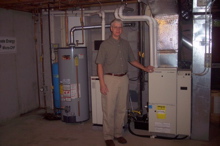
David Brownell stands next to the Climate Energy Freewatt cogeneration system in the basement of his house. (Photo: Bruce Gellerman)
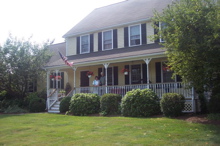
David Brownell’s house in Medway, MA. (Photo: Bruce Gellerman)
As Prachi Patel-Predd (Prah-chee pah-tell pred) of I-Triple E Spectrum magazine reports, the unique system can actually run your electric meter backwards and help save energy, money and, perhaps the planet.
[SOUND OF WALKING DOWN STAIRS]
PATEL-PREDD: David Brownell leads the way down to the basement of his colonial home in Medway, Massachusetts. At first glance, the heating system in the basement looks like an ordinary gas furnace. But Brownell’s comes with a few special attachments.
BROWNELL: What we have is a fairly small box the size of a large trash compactor, I suppose, that is the actual engine generator. And this is an internal combustion engine made by Honda. And it is a 160 cc natural gas fired internal combustion engine. To its side is a warm air furnace . . .
PATEL-PREDD: . . . which generates both heat and electricity. The Honda engine burns natural gas to run the generator. A heat exchanger traps the heat and uses it to warm Brownell’s home. It’s sort of like getting the electricity for free. Climate Energy, the Massachusetts-based company that makes this furnace, calls it ‘the free-watt system.’ The trick of generating heat and electricity together is called ‘cogeneration.’ Thomas Edison designed and built the first cogen plant back in 1882. Over the years, cogen plants have been used in hospitals and oil refineries. But now, Climate Energy is making cogeneration systems for homes.

David Brownell stands next to the Climate Energy Freewatt cogeneration system in the basement of his house. (Photo: Bruce Gellerman)
PATEL-PREDD: Cogeneration systems are far more efficient than regular coal-fired power plants, where nearly two-thirds of the heat that’s produced literally goes up in smoke through cooling towers or is lost over transmission lines. Cogen plants, like the free-watt system, are more than 90 percent fuel-efficient. That can make a big difference in utility bills. In test homes, Brownell estimates the system can save seven to eight hundred dollars a year—and help save the planet from global warming.
BROWNELL: So there’s about 15 or 20 homes that were evaluated and the amount of carbon dioxide savings from each of these homes varied from someplace around two and a half tons per year to three tons per year.
PATEL-PREDD: Free watt is mainly a heating system. In seasons that you don’t need heat the machine turns off and you pay your utility for electricity. But when you are using free watt and producing heat, you generate your own electricity. In about 15 states you can sell any extra electricity your system produces back to utility companies. Brownell says it’s a glorious thing to behold.
BROWNELL: The net result to the homeowner is that if they are operating the free-watt system and the electric loads in the house are low like at night time—typical situation—then what will happen is your electric meter will spin backwards.

Yes, David Brownell’s meter actually runs backwards. (Photo: Bruce Gellerman)
BANWELL: So the main market right now is in the northeast United States where you have high electric rates and fairly high number of days when you need to run your furnace. There are other areas of the country where technically you would save a lot in terms of the energy but it would take a little bit longer to pay for itself.
PATEL-PREDD: However, the free-watt system has one feature that could make it attractive just about anywhere.
[SOUND OF MOUSE CLICKING]
PATEL-PREDD: It comes with an Internet connection so you can see and set your home’s cogenerating power plant online from anywhere in the world. And so can your power company. The ability to remotely control the free-watt system could save utilities from building costly power plants. Again, David Brownell.
BROWNELL: One of the things down the road that we can provide is what’s called a ‘virtual power plant.’ And this is a situation where, let’s say you have 1,000 free-watt systems operating in a community like this and there was a brownout about to happen in an area. If there was an agreement in place and the utility was on board and the homeowner was on board, the utility could flip a switch and instantly turn on 1,000 free watts and have a 1.2-megawatt power plant operating right where they need it.
PATEL-PREDD: Here in the United States, the home cogeneration industry is in its infancy. Keyspan is the first—and so far—only utility to offer rebates for the furnaces. But in Japan, the UK, and Germany, cogen is soaring. There, governments and big utilities are helping customers buy cogen systems with tax credits and price discounts. Matt Dugan, Keyspan’s manager of residential energy efficiency programs, says the same thing is needed here.
DUGAN: The state and the federal government do offer tax credits on energy efficient installations in homes and businesses and it’s quite possible that this technology—once in the marketplace—may be identified as one that could receive a tax credit down the road.
PATEL-PREDD: If that happens, cogen systems like free watt could generate a lot of heat and shed some light on America’s quest for energy independence. For Living on Earth, this is Prachi Patel Predd.
CURWOOD: Prachi Patel-Predd is a reporter with I –Triple E Spectrum Magazine. For photos and more information about the free-watt system, check out our web page: L-O-E dot org.
Related links:
- Climate Energy LLC
- Link to the Spectrum IEEE story
- Keyspan Energy
[MUSIC: Ricardo Sliveira “O Monstro E A Flor (The Monster And The Flower)” from ‘Outro Rio’ (Adventure Music—2007)]
CURWOOD: Coming up: After 9-11 he was called America’s Mayor. Now he wants to be America’s president. A look at Rudolph Guiliani’s environmental record is just ahead right here on Living on Earth.
World’s Worst Polluted Places

Untreated sewage and mercury-contaminated sludge continue to be dumped haphazardly from chlor-alkali industries in Sumgayit, Azerbaijan. (credit: Petros Morgos)

Untreated sewage and mercury-contaminated sludge continue to be dumped haphazardly from chlor-alkali industries in Sumgayit, Azerbaijan. (credit: Petros Morgos)
Richard Fuller, the founder and director of the Blacksmith Institute has visited many of these most polluted places.
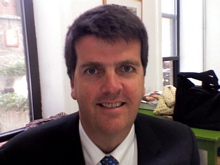
Richard Fuller, Executive Director of the Blacksmith Institute. (Courtesy of the Blacksmith Institute)
CURWOOD: Tell me of another place you visited, what you saw, how you felt—what happened as a result of your visit?
FULLER: Sure, Steve. I was recently in a little village called Muslimova, which is in the central part of Siberia, and it’s downstream from a large industrial complex that makes plutonium. And in the early 60s, there was an accidental release of radioactive material that flushed all the way down the river—in fact, all the way down to the Arctic Ocean. It was an enormous release. It was three times the size of Chernobyl in terms of the amount of radioactive material that was polluting the area.
And the Russian authorities had a very interesting response. They moved most of the towns and villages down the river. They physically relocated them as soon as possible afterwards but they left this one village – I think its population is around 20,000 people – probably to study it, to see what kind of effects radio-nuclear would have on that particular population. And they’ve been extraordinary. You go there now and the houses are all shuttered. Everyone has died, or had cancers, or multiple cancers. The second and third generation people of that particular village have all kinds of diseases and mental problems.

A health worker examines a man sickened from scavenging in the lead mines of Kabwe, Zambia. (credit: Blacksmith Institute)
CURWOOD: So, given that your top ten most polluted places, indeed the bulk of your ‘dirty thirty,’ are poor places—what does that say to you?
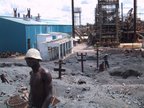
Young men look for metal near an abandoned lead mine in Kabwe, Zambia. Many children in the area suffer from severe lead poisoning. (photo credit: Blacksmith Institute)
CURWOOD: So if this is related to our consumption habits, what things might we have in our homes in North America or in the rich parts of the world that would have come from the people who have been exposed to all of this pollution?

Currently polluting factories in Sumgayit, Azerbaijan are using dated technologies and improperly disposing and treating industrial waste. (photo credit: Adam Klaus)
CURWOOD: Richard Fuller is the founder and director of the Blacksmith Institute. Thank you so much for discussing your report with me today.
FULLER: You’re welcome. It’s been a pleasure.
CURWOOD: You can learn more about the most polluted places in the world and read the Blacksmith Institute report on our website, L-O-E dot org.
Related link:
The Blacksmith Institute Report
[MUSIC: Floratone “Floratone” from ‘Floratone’ (Blue Note—2007)]
Giuliani’s Green Record
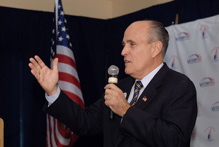
Rudy Giuliani addresses a crowd recently in New Hampshire. (2007 Bill Fish Photography)
CURWOOD: Americans just marked the sixth anniversary of the September 11th terror attacks.

Rudy Giuliani addresses a crowd recently in New Hampshire. (Photo: 2007 Bill Fish Photography)
But now the mayor faces criticism from some of his city’s emergency responders who say his administration failed to protect them from the toxic dust that spread over lower Manhattan.
Today Living on Earth begins a special series, looking at Election ‘08 and the Green issues on the road to the White House. Our Washington correspondent Jeff Young has our profile of republican hopeful, Rudy Giuliani.
[SIRENS, CHAOS ON STREETS OF NEW YORK AFTER 9-11]
YOUNG: It is one of the iconic images from 9-11: New York Mayor Rudy Giuliani
emerging from the dust of collapsed buildings to reassure his city.
GIULIANI: And I’d ask the people of New York City not to be frightened, to go about their lives as normal. Everything is safe right now in the city. And the people who are doing the relief effort need all the help they can get.
YOUNG: Giuliani’s action that day made him, as Time magazine put it, ‘America’s Mayor.’ It also launched his national political career. But decisions Giuliani made in the days and weeks following 9-11 are coming under fire. Many of the emergency responders and workers who removed debris from ground zero are sick, and many of them blame city officials for their exposure to toxic dust.
[CAPITOL HILL HALLWAY SOUNDS]
YOUNG: This summer, 9-11 workers crowded a congressional hearing on the federal government’s mismanagement of health threats at ground zero. Afterward, ironworker Richard Prager said the city is also to blame.
PRAGER: The city did nothing to protect workers. They did nothing, they really didn’t. It’s my fault I’m sick, basically is what they_re telling me.
YOUNG: Retired New York police detective Rich Volpe says he has some questions for
Mayor Giuliani.
VOLPE : I’d like to ask him what he didn’t do. And I have the answer to that: he didn’t shut down the site. He put thousands and thousands of people in danger for Wall Street to be opened. ‘What didn’t he do?’ That’s more the question to be asked.
[CAPITOL HALLWAY SOUNDS FADE OUT]
YOUNG: Workers like these say that safety precautions at the ground zero work site were inadequate and that the mayor bowed to business pressure to speed ahead with the cleanup rather than protect public health. In their eyes, the event that made Giuliani’s political reputation also provides disturbing insight into his environmental leadership.
KUPFERMAN: It’s an oxymoron. Mayor Giuliani was anything but an environmental leader.
YOUNG: That’s Joel Kupferman, director of the New York Environmental Law and Justice Project. He represents some of the sick 9-11 workers in a lawsuit against the federal government. Kupferman says documents obtained in that case indicate the city also put workers and residents at risk. In October 2001, New York associate public health director Kelly McKinney wrote a memo about reopening sections of the city near ground zero. Here, Kupferman reads what McKinney wrote about a meeting with the city’s Office of Emergency Management, or OEM.
KUPFERMAN: The mayor’s office is under pressure from building owners and business owners in the red zone to open more of the city to occupancy. DEP, that’s the New York City Department of Environmental Protection, believes that air quality at those locations is not yet suitable for re-occupancy. Following the meeting I was told that the mayor’s office - this is the mayor’s office - was directing OEM to open target areas next week.
YOUNG: McKinney did not respond to a request to clarify his memo. Kupferman says it shows a Mayor pressing to reopen parts of the city too quickly.
KUPFERMAN: There was still dust in people’s buildings, there was still dust on the streets. He was so gung ho of getting Wall Street open that he basically put environmental science to the winds.
YOUNG: Giuliani’s supporters vehemently deny that.
SHEIRER: It’s a false accusation; it’s not true. We did everything we can to make sure that we got people back into their homes and business as safely as possible.
YOUNG: That’s Richard Sheirer, who directed the Office of Emergency Management under Mayor Giuliani. Sheirer is now with Giuliani Partners, a security consulting company. The Giuliani campaign directed questions about the 9-11 health issues to Sheirer. Sheirer says he sympathizes with those who are sick but he dismisses their criticism.
SHEIRER: Well, it’s easy to sit here six years afterwards and look back on the situation with shoulda coulda wouldas. The criticism that they make today is, you know, looking back and getting information that wasn’t available to us then. We did everything possible to make sure that it was a safe worksite. Nobody at those days and the time right after foresaw what would happen and where we’d be today.
YOUNG: Today Rudy Giuliani leads the Republican pack in the presidential race. He rarely strays from his core message of national security. Questions on other topics, say global warming, become answers about energy security, as in this forum in New Hampshire.
GIULIANI: Energy independence should be for us, it should be what putting a man on the moon was to the generation in the 1950s and 1960s and 1970s. It should be a major government enterprise, private enterprise, and we should further every single one of the alternatives. My major concern is that lack of energy independence is a national security problem. The idea that all this money is flowing particularly to parts of world where they_re breeding, uh, Islamic terrorism is very, very dangerous.
YOUNG: Giuliani supports expanding energy production across the board: renewable energy as well as coal, nuclear and more domestic oil and gas production. His answer demonstrates a detailed knowledge of energy issues. But when it comes to how government should act, he’s a bit more vague.
GIULIANI: I don’t like mandates. I don_t think mandates generally work and I think mandates are somewhat inconsistent with the kind of economy and the kind of society that we have.
YOUNG: Giuliani’s top advisor on energy issues is John Herrington, who served as President Ronald Reagan’s energy secretary. Herrington says Giuliani would open new areas to oil drilling, including the Arctic National Wildlife Refuge, but realizes the country must develop new transportation fuels. And while Giuliani calls global warming a serious problem, Herrington says he rejects the remedy most advocates of climate action propose: a cap on carbon emissions.
HERRINGTON: Number one, it has not worked in Europe. Number two, you raise the price of energy to all consumers. So it’s better to address the issue not through some sort of regulatory environment. It’s better that we go to sources of energy that don’t have as much emissions, and that would be a nuclear power option.
YOUNG: Herrington says Giuliani’s goal would be to increase nuclear to become 25 percent of the country’s electricity mix. It’s currently about 20. All this leaves environmentalists, like Gene Karpinski of the League of Conservation Voters, lukewarm.
KARPINSKI: The good news is he acknowledges the fact that global warming is real and it’s at least in part being caused by humans. But the bad news is that he’s got no plan to solve it. That sounds a lot like George Bush. If you’re not for mandates, you’re not serious about solving the problem.
YOUNG: Karpinski also gets little encouragement from the company Giuliani has kept
since leaving the Mayor’s office.
KARPINSKI: One is that he’s got the largest contributions by far from the oil and gas industry this year. Secondly, the firm that he’s associated with is one of the most anti-environmental firms in Washington, D.C.
YOUNG; That law firm is Bracewell and Giuliani. It does lobbying and legal work for some of the nation’s biggest polluters, including coal burning power plants, oil refineries, and, in one case, even the Saudi Arabian oil ministry. Their lobbyists are omnipresent and outspoken at Washington environmental events. When the U.S. Supreme Court heard a global warming case, Bracewell and Giuliani lawyer Scott Segal took to the courthouse steps to defend the Bush administration’s inaction on climate change.
SEGAL: EPA was correct not to regulate. Adopting unilateral, mandatory carbon caps is the wrong way to go.
YOUNG: But Segal is uncharacteristically silent on Mr. Giuliani’s work at the firm. He says the Giuliani campaign calls the shots on such interview requests. The campaign did not respond.
Meanwhile, many of the firm’s partners, employees and influential clients add big money to the Giuliani campaign. At least two of the firm’s employees are now among Giuliani’s cash bundlers—people who round up more contributors for the campaign ahead.
For Living on Earth, I’m Jeff Young in Washington.
Related links:
- Guiliani campaign website on energy issues
- League of Conservation Voters is tracking the candidate’s statements on climate change.
- Public Citizen tracks campaign cash
- Memo sent to EPA Mckinney on Ground Zero air quality concerns
[MUSIC: The Specials “A Message to Rudy” from ‘The Greatest Hits’ (Cleopatra—2006)]
Is Energy Independence the Answer?
CURWOOD: Rudy Guiliani is not the only one talking about energy independence. It seems to be the mantra of just about all the presidential candidates, not to mention other politicians in Washington. For some, the goal is lower gas prices. For others, it’s concern that oil-rich regimes hold sway over foreign policy. But commentator Gernot Wagner argues either way, energy independence gets us nowhere.
WAGNER: Talk of energy independence misses the point. The goal must be energy security. This is most often achieved by diversifying dependence, not by calling for independence.
President Richard Nixon started the craze with Project Independence in 1973. It has been a losing battle from the start. At the launch of the project, the U.S. imported a third of its oil. Now it imports over 60 percent.
Without draconian measures, energy independence is unachievable. The cheapest available oil, at the moment, is from the Arabian Peninsula. Meeting all need for oil domestically would come with a hefty price tag.
And those willing to pay a higher price in order to extricate foreign policy from perceived oil grip would do well to remember that the regimes they seek distance from will be enriched by that higher price. The market for oil is global. That makes it pointless to try to wean ourselves off particular suppliers.
The U.S. can declare today that it will not import any oil from Saudi Arabia. There is enough oil on the market to avoid shipping directly from Saudi to American ports. Someone else will gladly take the shipments from Saudi Arabia. But as long as there is no universal boycott of Saudi oil, we will be dependent on it – and we will still have U.S. tanks in the Middle East, if not U.S. tankers.
It is even more dangerous to link energy independence with environmental goals. We need to get away from oil and promote alternatives, but decreasing pollution is not the same as decreasing energy imports. Ethanol, for example, can deal with pollution but, for the most part, should not be used to address independence.
At the moment, the best source for ethanol is sugar cane. On environmental grounds, cane beats born by a long shot. The most sensible environmental policy would be to drop all ethanol tariffs.
But slashing tariffs on ethanol increases our reliance on foreign fuels. Ethanol production shifts to Brazil, which could, at some point, replace Saudi Arabia as the lowest cost producer of the world’s fuel of choice. Energy independence would decline. At the same time, energy security would go up. A democratic Brazil is clearly a better energy supplier than an autocratic Middle East. Even so, relying too heavily on Brazil could undermine supply security just as well. The goal should be to diversify.
Calls for energy independence undermine what really matters. The distinction with energy security is subtle, but important. Not only is energy independence unachievable, it is not even desirable.
CURWOOD: Gernot Wagner is a consultant living in New York. What’s your opinion on energy independence? Is it out of our reach, as Gernot Wagner, suggests, or should it be America’s goal? Tell us your thoughts. Send an email to us at comments at loe.org. Once again, comments at L-O-E-dot-O-R-G. Our postal address is 20 Holland Street, Somerville, Massachusetts, 02144. And you can call our listener line, at 800-218-9988. That's 800-218-99-88.
[MUSIC: Chico Hamilton “My Brother Don” from ‘Hamiltonia’ (Joyous Shout—2007)
CURWOOD: Just ahead: choosing herbal medicine as standard practice. Keep listening to Living on Earth.
ANNOUNCER: Support for the environmental health desk at Living on Earth comes from the Cedar Tree Foundation. Support also comes from the Richard and Rhoda Goldman Fund for coverage of the population and the environment. This is Living on Earth on PRI, Public Radio International.
Family Farmacia
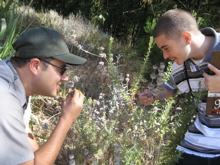
Antony Jauregui and park ranger and ethnobotanist Antonio Solorio share a moment with black sage in the Santa Monica Mountains. (Courtesy of Youth Radio)
CURWOOD: It’s Living on Earth. I’m Steve Curwood. Herbal remedies have become a huge business as people seek alternative ways to get better and ward off illness. But for Youth Radio’s Antony Jaureguí (How'-re-Gee,(hard G)), herbal medicine isn’t the alternative; it’s a long-standing tradition in his family.
JAUREGUI: For many generations, my family has passed down the Mexican tradition of growing medicinal herbs to treat and cure everyday ailments. Because I am growing up in the U.S., I am afraid that my connections to these plants might get lost.
It’s important to me not just to gain knowledge of these valuable plants, but to share it with people who could benefit from their use. Let’s go on a little scavenger hunt with my mom in her garden.

Antony Jauregui and park ranger and ethnobotanist Antonio Solorio share a moment with black sage in the Santa Monica Mountains. (Courtesy of Youth Radio)
MRS. JAUREGUI: Sera el cambio de tierra que le hice pero me salio muy bonito . . .
JAUREGUI: This is my mom admiring her epazote plant. We’ve used plants like these throughout my childhood. I’ve been gathering plant samples and taping them into my notebook, writing all I know about each one. Most of what I know of medicinal plants comes from seeing my mom use them.
MRS. JAUREGUI: Vivia en un lugar que para todos usaban hierbas; cada ves que se enfermaba alguien-- pura hierba.
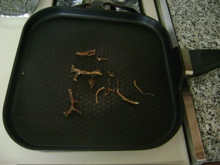
One of Antony's favorite medicinal concoctions is dandelion tea. Here he demonstrates the roasted dandelion root. (Courtesy of Youth Radio)
MRS. JAUREGUI: Para insomnio, para colicos, para dolores en la espalda, la cabeza, vomito . . .
JAUREGUI: …insomnia, back pains, nausea, headaches. My mom’s list of herbal remedies cure all sorts of complaints. It’s my work now to continue her tradition, and I’m trying to learn as much as I can about the plants in my region. Let’s take a walk through the Santa Monica Mountains with Antonio Solorio.
[SOUND OF WATER RUNNING]
SOLORIO: This plant right here—this tree I should say-- the willow is actually a medicinal tree. And the Native Americans original to this area, which are known as the Chumash, use this as a medicine.
JAUREGUI: Antonio Solorio is an ethno-botanist and park ranger who has been studying traditional medicinal gardens in east Los Angeles.
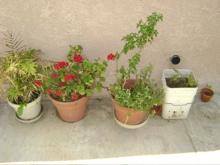
These are some of the home grown medicinal plants in Antony's mother's garden. (Courtesy of Youth Radio)
JAUREGUI: Antonio Solorio has a very practical reason for why many families use backyard herbs as medicine.
SOLORIO: Growing up in east Los Angeles, in a working, poor family, we didn’t have a health insurance network. Our Kaiser was my mom’s backyard.
JAUREGUI: High healthcare costs have many Latino families, like Antonio’s, returning to traditional medicine. But certain plant medicines found in their home countries are not available here in the U.S.
SOLORIO: Not even in the local mercados that would cater to a certain cultural group. Also when you move to an urban area, your culture—certain practices are getting replaced and it’s kind of part of that whole process, I guess, of migrating.
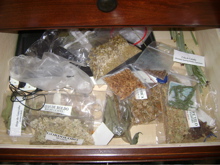
Antony is quite proud of his "loot": an assortment of dried and ground medicinal plants, which he has prepared himself. (Courtesy of Youth Radio)
HOLLIDAY: With Latino approaches sometimes there this idea of backwardness…
JAUREGUI: Karen Holliday is an anthropologist who spends a lot of time in botanicas, which are part-pharmacy, part-spiritual center, where many immigrants seek counseling for everything from back pains to bad luck.
HOLLIDAY: Immediately the way that Latinos were portrayed as well as the botanicas were superstitious, witchcraft, occult, devil worshipping, and that’s a very narrow way of looking at people.
JAUREGUI: People probably aren’t worshipping the devil at botanicas, but some powders and mixtures sold there are known to do more harm than good. Like when they contain poisons. One example is a powder called greta from Mexico that’s used to treat indigestion. It’s been found by the Centers for Disease Control and Prevention to have very high levels of lead. And there is another important reason to look beyond medicinal herbs, says Dr. Steven J. Brown from the AIDS Research Alliance in Los Angeles.
BROWN: Not to say there won’t be some certain interventions that affect the illness, but I think it’s important to make a distinction between the disease, which the patient has, and the illness, which people experience. Most cancers such as gastric ulcers, which has turned out to be a bacteria, need to be treated with antibiotics. Many neurological diseases such as Parkinson’s or Alzheimer’s can only be treated really medically.
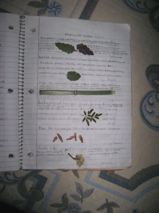
Antony cuts and pastes medicinal plants into his notebook, with information about each plant. (Courtesy of Youth Radio)
I often prepare my own dandelion coffee and it’s actually the process in which it is made that has that soothing effect. It’s supposed to be an excellent tonic for the liver. It’s really good for circulation. Here I have some dandelion roots that we grounded, and we roasted and then we grounded. And I have it right here in my bag. Let me get the boiling water ready.
[SOUND OF POURING WATER]
JAUREGUI: I put it in my mug and we can make some dandelion coffee.
[SOUND OF SILVERWARE TOUCHING MUG]
JAUREGUI: And now I’m going to have a little sip.
[SOUND OF SIPPING TEA AND SIGH OF SATISFACTION]
JAUREGUI: For Living on Earth, I’m Antony Jáuregui.
CURWOOD: Antony Jáuregui is a correspondent for Youth Radio. He recently left Los Angeles to study environmental science and journalism at Northern Arizona University in Flagstaff.
Related link:
Youth Radio
[MUSIC: Ricardo Silveira “Agua Da Nascente (Water From The Spring)” from ‘Outro Rio’ (Adventure Music—2007)]
Sacred Sea
CURWOOD: Lake Baikal, in the middle of Siberia, is no ordinary lake. One hundred eighty six miles long, one mile deep, and 25 million years old, Baikal is the oldest, deepest lake and holds more fresh water than any other lake in the world.
For Peter Thomson, a freelance journalist and former Living on Earth senior editor, Lake Baikal also holds countless stories waiting to be told. To get there, Peter and his brother, James, traveled across the Pacific Ocean by freighter to Siberia.
He writes about their adventure in his new book, “Sacred Sea, a Journey to Lake Baikal.” Peter, tell me about this amazing place—what does it look like?
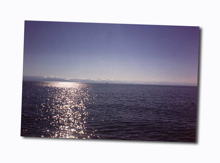
Lake Baikal. (Photo: Peter Thomson)
CURWOOD: So, you go halfway around the world to this place. And you’re standing-- your first day-- on the shore of Lake Baikal. The van that’s taken you from the train station has broken down and there you are getting your first up-close look and touch of this place. I mean, was it everything you expected?
THOMSON: Well, it was and it wasn’t and it was a very weird experience, which I try to describe in the book although I’m not sure that I really captured it. We had been traveling through Russia for a week at that point and we were tired, we were a little bit sick, we were incredibly disoriented—my brother and I—and in a way it was this very anticlimactic experience. You know, you’ve traveled halfway around the world to this place that you have revered and that everyone who knows about it says, ‘Oh my God, I’ve got to get there!’ And you get there and you’re just sort of tumbled out onto the beach and all of a sudden there’s this water. And you go up and you look at it and you touch it and—it’s just water.
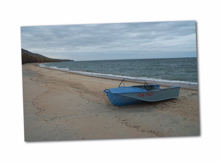
Baikal Beach. (Photo: James Thomson)
CURWOOD: You sure it wasn’t that Russian vodka?
THOMSON: Uh, actually, now that you mention it.
CURWOOD: What makes Lake Baikal so special? What makes it ecologically unique?
THOMSON: Well, it’s incredibly pure. And that’s a result both of sort of geologic processes and biologic processes and I think most people think of purity as something that’s, you know, a result of human processes but actually in Baikal it’s what scientists call oligotrophic, which means it has almost no nutrients or minerals in it.
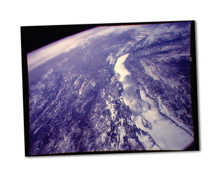
Lake Baikal. (Courtesy of the Image Science and Analysis Laboratory, NASA Johnson Space Center (http://eol.jsc.nasa.gov))
And at the top of the food chain you have the world’s only unique species of freshwater seal. There is no other freshwater seal anywhere in the world than the Baikal seal, which is called the ‘nerpa’ locally. And it somehow made it’s way upriver from the Artic Ocean—2,000 miles of river—to this lake.
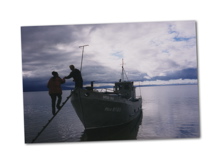
Baikal Silhouette. (Photo: Peter Thomson)
THOMSON: Well, it’s almost difficult to imagine—living in the United States. You know, we have a number of incredibly beautiful, revered places like Yosemite Valley and the Grand Canyon, which we think of as sort of these pinnacles of wonder in the natural world. But if you could somehow add a layer of religious fervor and deep nationalism to your engagement with those places you might have an idea of what it’s like to be a Russian imagining Lake Baikal.
Millions of Russians feel they need to have a pilgrimage to Baikal in their lifetime sometime. Almost like Muslims wanting to go to Mecca for the Hajj or Christians or Jews wanting to go to Jerusalem.
And most of those people don’t make it there but on my way into the lake, I was riding in on the train and I spent most of my time looking out the windows and I was usually the only person in the hallway but all of a sudden I see a glint of blue out the window and the hall fills with people and they are singing. And they are toasting with vodka and tea. And I don’t know Russian but what I could understand was Baikal. They were singing this ode to their lake and it was an incredibly powerful and moving experience to witness that, and it gave me a sense that this was a place which was unlike anything that I’d ever experienced before in terms of their relationship to it.
CURWOOD: So, Lake Baikal is this amazingly pure, intact ecosystem but it faces an awful lot of challenges, you found.
THOMSON: Yeah, well, I mean I went in I think somewhat eyes wide open. You know, I knew that it was probably as close to intact as you can get for a large body of water like this but also that there were definite threats to it.
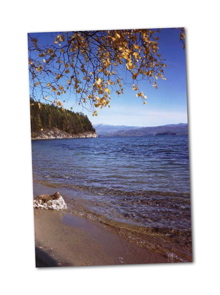
Chivyrkuysky Gulf, Lake Baikal. (Photo: Peter Thomson)
On the other hand, there’s a lot of industry and cities upstream in Mongolia and Eastern Siberia that flow by river into the lake so there is real impact on the lake. And then there are a couple of paper mills-- one in particular that’s right on the lake-- that have a very strong local impact and traces of this pollution are found throughout the food chain, throughout the water, from top to bottom of the lake. So there are some real concerns there, to be sure.
CURWOOD: By writing this book, of course, somebody a hundred years from today can take a look at it. What do you think will have changed in Lake Baikal from today to say, a hundred years from now? And why would someone perhaps be grateful for the record you’ve created, based on today?
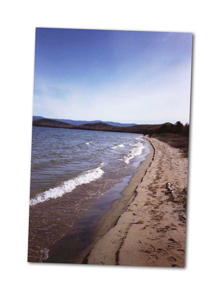
Chivyrkuysky Gulf, Lake Baikal. (Photo: Peter Thomson)
I’m not certain that that will happen but I sure hope so because it’s entirely possible that we can do that. We know enough not to make the same mistakes there that we’ve made elsewhere, to pull back from the industrial impacts in the region, to build an economy there that is based on an intact ecosystem rather than at the expense of the ecosystem, through clean, low-impact industry, through a recreational economy, really, I mean it can’t be much more than that without having much of an impact.
It’s a very tough trick to turn as people are learning all around the world as they do try to develop what is called ‘ecotourism’ or ‘sustainable tourism’ but I think that Baikal is the kind of place where it’s still possible to do the right thing by nature and by the people who live there and there have been people there for thousands of years. So I hope in a hundred years that that will be what people remember and that this book somehow played a role in making that possible.
CURWOOD: Peter Thomson’s book is called “Sacred Sea: A Journey to Lake Baikal.” Thank you so much, Peter.
THOMSON: Thanks, Steve.
CURWOOD: To see photos of Lake Baikal and hear Peter reading from his book, go to our website, loe.org.
Photo: (16-1 Baikalsk Pulp and Paper Mill)
Caption: Baikalsk Pulp and Paper Mill. (Photo: Peter Thomson)
Related links:
- Great Baikal Trail, Homepage
- Baikal Environmental Wave
- UNESCO World Heritage List
- Sacred Sea Reading
- Science and the City
[MUSIC: Ant Fort “Morning: Good” from ‘A Long Story’ (ECM—2007)]
CURWOOD: On the next Living on Earth: The Catholic Church in Latin America has a long and bloody history of political activism, known as liberation theology. Now, some priests and nuns are risking their lives opposing environmental destruction from logging and mining.
SNELL: He told me that every day he expected it would be his last but he didn’t have a choice. This is what he felt he had to do.
CURWOOD: A report from the frontlines of liberation ecology, next time on Living on Earth.
[LAKE SOUNDS AND WILDLIFE]
CURWOOD: We leave you now on the shoreline of a Canadian lake.
[“American Forests and Lakes” (Sittelle, 1989)]
CURWOOD: Blackbirds, and white-throated sparrows are abundant in the reeds surrounding this body of water. And if you listen closely you’ll hear the unusual pumping sound of the American Bittern, as recorded by Jean Roché (French for John and Row-shay)
[“American Forests and Lakes” (Sittelle, 1989)]
CURWOOD: Living on Earth is produced by the World Media Foundation. Our crew includes Ashley Ahearn, Eileen Bolinsky, Bruce Gellerman, Ian Gray, Ingrid Lobet, and Jeff Young - with help from Bobby Bascomb, James Curwood, and Kelley Cronin. Our interns are Alexandra Gutierrez (goo – tuh-rez) and Mitra Taj (mee-tra tahge). Jeff Turton is our technical director. Alison Lirish Dean composed our themes. You can find us anytime at loe.org. I’m Steve Curwood. From all of us here at Living on Earth, thanks for listening.
ANNOUNCER: Funding for Living on Earth comes from the National Science Foundation, supporting coverage of emerging science; and Stonyfield Farm: organic yogurt and smoothies. Stonyfield pays its farmers not to use artificial growth hormones on their cows. Details at Stonyfield dot com.
Support also comes from you our listeners, the Ford Foundation, the Town Creek Foundation, and the Saunders Hotel Group of Boston’s Lennox and Copley Sqaure Hotels. Serving you and the environment while helping preserve the past and protect the future, 800-225-7676. Living on Earth is also funded by Pax World Mutual Funds—socially and environmentally sustainable investing. Pax World, for tomorrow. On the Web at paxworld dot com.
ANNOUNCER: PRI, Public Radio International.
Living on Earth wants to hear from you!
Living on Earth
62 Calef Highway, Suite 212
Lee, NH 03861
Telephone: 617-287-4121
E-mail: comments@loe.org
Newsletter [Click here]
Donate to Living on Earth!
Living on Earth is an independent media program and relies entirely on contributions from listeners and institutions supporting public service. Please donate now to preserve an independent environmental voice.
NewsletterLiving on Earth offers a weekly delivery of the show's rundown to your mailbox. Sign up for our newsletter today!
 Sailors For The Sea: Be the change you want to sea.
Sailors For The Sea: Be the change you want to sea.
 The Grantham Foundation for the Protection of the Environment: Committed to protecting and improving the health of the global environment.
The Grantham Foundation for the Protection of the Environment: Committed to protecting and improving the health of the global environment.
 Contribute to Living on Earth and receive, as our gift to you, an archival print of one of Mark Seth Lender's extraordinary wildlife photographs. Follow the link to see Mark's current collection of photographs.
Contribute to Living on Earth and receive, as our gift to you, an archival print of one of Mark Seth Lender's extraordinary wildlife photographs. Follow the link to see Mark's current collection of photographs.
 Buy a signed copy of Mark Seth Lender's book Smeagull the Seagull & support Living on Earth
Buy a signed copy of Mark Seth Lender's book Smeagull the Seagull & support Living on Earth

